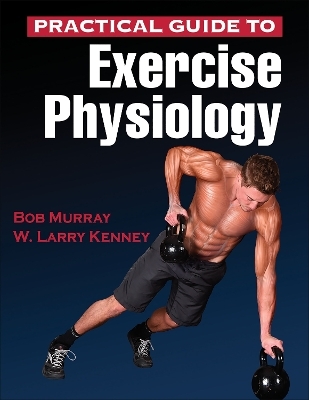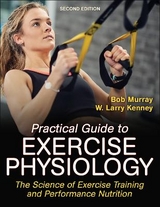
Practical Guide to Exercise Physiology
Human Kinetics (Verlag)
978-1-4504-6180-1 (ISBN)
- Titel erscheint in neuer Auflage
- Artikel merken
Practical Guide to Exercise Physiology guides readers through the scientific concepts of exercise physiology with highly visual, easy-to-follow content. The text applies complex concepts of physiology to exercise program design, giving personal trainers, strength and conditioning specialists, and other health and fitness professionals an accessible resource to use with their clients. Written specifically for those in the fitness industry, the text covers various training goals and considerations when working with clients and athletes at all levels.
This guide takes an application-based approach in describing intricate physiological processes so that professionals can select and explain the appropriate exercises and physical activity regimens for clients. The text is complemented by medical artwork that puts complex systems in a digestible visual context. These systems are then applied to real-world practice through explanations of exercises that are beneficial to specific body systems and instructions on combining various exercises to achieve the desired results.
Part I of Practical Guide to Exercise Physiology is a review of the fundamentals of physiology, including muscles and muscle adaptation, bioenergetics, and the cardiorespiratory system. It also details the various activities and processes that contribute to fatigue. Part II applies and expands on this information to address the design of training programs for achieving specific goals. These goals include increasing muscle mass and strength; losing weight; and developing speed, power, and aerobic endurance. Finally, part III addresses adaptations and special considerations of these training programs, including adjustments for changes in altitude or temperature and considerations for special populations such as children, older adults, and pregnant women.
Alongside the content and illustrations, Practical Guide to Exercise Physiology includes tools that apply concepts to everyday practice:
• Factoid boxes engage readers with additional facts about the human body and its response to training.
• Sidebars throughout the text pinpoint current topics of concern so that personal trainers and fitness professionals can prepare for and respond to these issues.
• An index of common questions from clients is an easy reference on client education.
• Sample training programs illustrate how the scientific concepts that guide program design are used in practice.
Practical Guide to Exercise Physiology contains all the necessary information for new and current personal trainers and fitness professionals. Readers will gain confidence in designing exercise programs for various populations and the ability to explain to clients how each exercise and movement will help them achieve their goals.
Bob Murray, PhD, FACSM, is the cofounder of the Gatorade Sports Science Institute (GSSI) and served as director from 1985 to 2008. Murray oversaw a broad program of GSSI- and university-based research in exercise science and sport nutrition that set industry standards and consumer expectations for science-based product efficacy. Murray has been an invited speaker at professional meetings worldwide. A native of Pittsburgh, Murray earned his BS and MEd degrees in physical education at Slippery Rock University. He was an assistant professor of physical education and head swimming coach at Oswego State University from 1974 to 1977 before earning his PhD in exercise physiology from Ohio State University. He then was assistant and associate professor of physical education at Boise State University from 1980 to 1985 before relocating to Chicago to cofound the Gatorade Sports Science Institute. An author of numerous publications in scientific texts and journals, Murray is a fellow of the American College of Sports Medicine and an honorary member of the Academy of Nutrition and Dietetics. W. Larry Kenney, PhD, is the Marie Underhill Noll Chair in Human Performance and a professor of physiology and kinesiology at Pennsylvania State University at University Park. He received his PhD in physiology from Penn State in 1983. Working at Noll Laboratory, Kenney is researching the effects of aging and disease states such as hypertension on the control of blood flow to human skin and has been continuously funded by NIH since 1983. He also studies the effects of heat, cold, and dehydration on various aspects of health, exercise, and athletic performance as well as the biophysics of heat exchange between humans and the environment. He is the author of more than 200 papers, books, book chapters, and other publications. Kenney was president of the American College of Sports Medicine from 2003 to 2004. He is a fellow of the American College of Sports Medicine and is active in the American Physiological Society. For his service to the university and his field, Kenney was awarded Penn State’s Faculty Scholar Medal, the Evan G. and Helen G. Pattishall Distinguished Research Career Award, and the Pauline Schmitt Russell Distinguished Research Career Award. He was awarded the American College of Sports Medicine’s New Investigator Award in 1987 and the Citation Award in 2008. Kenney has been a member of the editorial and advisory boards for several journals, including Medicine and Science in Sports and Exercise, Current Sports Medicine Reports (inaugural board member), Exercise and Sport Sciences Reviews, Journal of Applied Physiology, Human Performance, Fitness Management, and ACSM’s Health & Fitness Journal (inaugural board member). He is also an active grant reviewer for the National Institutes of Health and many other organizations. He and his wife, Patti, have three children, all of whom are or were Division I college athletes.
Part I. Warming Up: Physiology 101
Chapter 1. Muscles Move Us
How Do Muscles Work?
How Do Muscles Adapt to Training?
How Do Muscle Cells Get Bigger and Stronger?
Chapter 2. Food Really Is Fuel
From Food to Energy
How Do Nutrients Fuel Muscle?
What About Vitamins and Minerals?
Water Is a Nutrient, Too
Chapter 3. Muscles Need Oxygen
How Does Oxygen Get to Muscles?
How Does Oxygen Use Relate to Fitness and Energy Expenditure?
How Does Training Help the Body Use More Oxygen?
Oxygen Delivery and Performance Enhancement
Chapter 4. Fatigue: What Is It Good For?
What Causes Fatigue?
What’s the Difference Between Fatigue and Overtraining?
What Role Does Fatigue Play in Adaptations to Training?
Part II. The Science of Training Program Design
Chapter 5. Principles of Designing Training Programs
What Are the Basics of Program Design?
What Makes an Effective Training Program?
Training Terms
Chapter 6. Training to Improve Muscle Mass and Strength
How Do Strength and Mass Increase?
What’s the Best Way to Gain Strength and Mass?
What’s the Role of Nutrition?
Chapter 7. Training for Weight Loss
Weight Loss Is All About Energy Balance
Why Do Some People Have Difficulty Losing Weight?
What’s the Best Way to Lose Fat but Protect Muscle Mass?
Chapter 8. Training for Speed and Power
What Are Speed and Power?
What Adaptations Are Needed to Improve Speed and Power?
What Kinds of Training Improve Speed and Power?
What Does a Speed and Power Training Session Look Like?
Chapter 9. Training for Aerobic Endurance
What Are the Main Adaptations to Aerobic Training?
What’s the Best Way to Improve Aerobic Endurance?
Should Endurance Athletes Engage in Strength Training?
Why Is Endurance Capacity Important for Sprinters and Team-Sport Athletes?
Part III. Special Considerations
Chapter 10. Heat, Cold, and Altitude
Exercise in the Heat Impairs Performance
Cold Stress Chills Performance
Exercise at Altitude
Chapter 11. Training Children, Older Adults, and Pregnant Women
Do Children Respond Differently Than Adults to Exercise Training?
Can Children Improve Strength With Training?
Can Older Adults Adapt to Training?
Should Women Exercise During Pregnancy?
| Verlagsort | Champaign, IL |
|---|---|
| Sprache | englisch |
| Maße | 216 x 279 mm |
| Gewicht | 703 g |
| Themenwelt | Sachbuch/Ratgeber ► Gesundheit / Leben / Psychologie |
| Sachbuch/Ratgeber ► Sport ► Fitness / Aerobic / Bodybuilding | |
| Studium ► 1. Studienabschnitt (Vorklinik) ► Physiologie | |
| ISBN-10 | 1-4504-6180-8 / 1450461808 |
| ISBN-13 | 978-1-4504-6180-1 / 9781450461801 |
| Zustand | Neuware |
| Haben Sie eine Frage zum Produkt? |
aus dem Bereich



